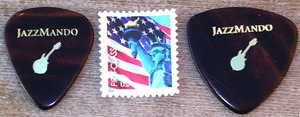« The tape does not lie... |
Main
| FFcP Key Patterns »
 January 24, 2008 | Top Picks January 24, 2008 | Top Picks
Picks are one of the least expensive ways you can change your sound. Every note you play starts with the pick, and your efforts to develop your own sound will always be contingent on its control and just how much you are "one with the pick."
If we were to recommend one pick (why, the JazzMando pick, of course!) we'd be as disingenuous as a shoe store clerk recommending everyone buy a size 7 wide Urban Moccasin in red suede (personal fave here at the JazzMando campus). Ridiculous to be so narrow because just like not everyone's feet are the same, neither are their hands, let along playing contexts. (Those Urban Moccasins aren't so cool at a Governor's Inauguration; speaking from experience.)
Let's articulate generalities, and yes, there will be exceptions to these, so take them with a grain of salt. The majority of mandolinists gravitate toward larger (1.5 mm and up), rounder picks (Fender 346) than guitarists. The Fender 351 shape is by far the most popular shape, but ironically, to get more sound out of our smaller instrument, we seem to need thicker and bigger to pull tone out of the double courses. Of course those more dependent on a fluid tremolo might prefer something thinner (Evan Marshall, Marilyn Mair, Don Stiernberg for example), but we'll leave it to you to experiment on what works best for your style of music.
Five areas of pick make-up for you to consider, and as we list them, we'll use a few nonsensical syllables to get the point across on how they affect tone. You'll probably come up with a few ideas yourself, and that's fine; it's all part of the exploration.
Mass (rigidity) Poh vs Doh
A flexible pick is great for the single courses of a guitar but mandolin really does better with something more rigid. Now pick flexibility CAN be good for tremolo, but there's something to be said for the control found in a stiff pick. You can probably accomplish better articulation if the suppleness is in your wrist rather than your pick. Stiffness yields "Doh" instead of "Poh."
Size (thickness) Dee vs Tee
Along the same lines (almost inseparable) as mass is pick thickness. A thicker pick creates volume with less stress on the hand and wrist. Guitar players struggle with this notion, but the majority who switch to mandolin find a hefty pick is actually less work than a weak, wimpy one. Like using a heavier bowling ball to knock more pins over, once you get a basic degree of control down, the pick works for you. Heavy yields a round "Dee" instead of a tepid, front-loaded "Tee."
Bevel (edge) (Szee vs Tzee)
You'll only notice these in a pick that's bigger than 1.14 mm, but if the pick has a more rounded bevel, you get more of the string fundamental, rather than the "snap" of articulation. Some pick hand-crafters spend a lot of time making these, as machining to produce these is not particularly effective. That means the price will be significantly higher, but don't underestimate the power of a polished pick bevel, which yields "Szee" over "Tzee," especially in a succession of rapid notes.
Point (contact surface) Dih vs Kih
Pointy picks or round tip? The rounded shoulders of an isosceles Fender 351 triangle are used by many a player, but why have two corners to wear when you can have three? The extra mass of a larger rounded (346) triangle can be useful for bigger sound, too. Some like a real pointy tip to the pick, arguably a much more one-dimensional sound, and one which we'd struggle to be fond of. More corner surface also yields more string fundamental, which means more string, less pick snap in your sound. Think "Dih" instead of "Kih."
Construction (material) Dee vs Dah vs Doh
Celluloid, Acetate, Delrin, Acrylic, bone, horn, tortoise, tin, there are a ton of materials out there to make a pick, and each of these will affect tone, playability, mass, rigidity, you name it. These are going to be as personal as what flavor ice cream you get for your next Baskin-Robbins trip. We won't give any recommendations here except to say you can alter stiffness and mass by using any variation of pick materials. We happen to like the middle-of-the-road Acetate picks of the D'andrea Pro-plec line because of the balance of weight and stiffness, and the ability to produce a hefty pick thin enough to still have a healthy bevel (1.5 mm).
Other variations, cat tongue grip, holes for lightness and/or grab, fin picks (we don't know what the heck good these do) are all out there, and we'd never discourage experimentation. You still want to find a pick to settle in to so you can achieve some degree of consistency in your pick control.

Posted by Ted at January 24, 2008 2:57 PM

Disclaimer: In the 'Information Age' of the 21st Century,
any fool with a computer, a modem, and an idea can
become a self-professed 'expert." This site does not
come equipped with 'discernment.'
|



